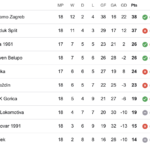December the 25th, 2024 – For the Croatia experts out there, this will likely not be new info. If you’re just discovering this remarkable country, however, you might be surprised. Here are 10 facts about Croatia you might not know.
When you picture Croatia, you likely conjure up images of the azure Adriatic Sea and sun-drenched, idyllic landscapes dominated by rugged mountains and dense pine forests. Palm trees, beer and good food aren’t all the country has to offer, however, and there are endless surprising things to learn about a country many underestimate the depth of.
It Had a Forbidden Island That Only Opened in 1991

The 1990s were years in which Croatia was engulfed in a bloody war for its own independence from Yugoslavia. The position of the country’s most far-flung island, Vis, saw it become the perfect strategic point. Josip Broz Tito made Vis his naval base, with a 110 metre submarine base carved into the rock. This island was a no go area for all foreigners up until 1991.
Since 1991, the proverbial doors of beautiful Vis have been open to all, and people from across the world come to enjoy the formerly forbidden Yugoslav island, far from Croatia’s mainland. Full of beautiful beaches, natural landscapes to die for and the popular Blue Cave (Modro jezero), the Vis of today is a far cry from its secretive military past.
It is (probably) Home to Europe’s Oldest Continually Inhabited Town

Vinkovci is allegedly the oldest continually inhabited town in all of Europe, having never been abandoned for any period of time at all for well over 8,000 years. The ancient finds don’t stop there either, with the oldest calendar in Europe also having been discovered there during the construction of a hotel in the centre of town. Two Roman Emperors, Valentian the Great and his brother Valens, were both also born in Vinkovci.
Hardly anyone who has travelled to the glorious Croatian coast for which the country is so famous has ever heard of Vinkovci, given that it lies far from the shore in the continental part of the country. Given the fact that it has provided so much to the world, that’s a crime in itself.
Dubrovnik Was Once An Autonomous Republic

The beautiful Pearl of the Adriatic is Croatia’s southernmost city and famed for its tourism. Home to some of the best preserved Mediaeval walls in the world and popularised even further owing to the hit series Game of Thrones, few know that Dubrovnik used to be a self-governing state in its own right.
Known as the Republic of Ragusa, or the Dubrovnik Republic, Dubrovnik was renowned for its diplomacy. Be it through settling relations with the envious Venetian Empire just across the Adriatic Sea or the marauding Ottoman forces who were conquering swathes of land in close proximity, the Dubrovnik Republic was a forward thinking and peaceful state which forged workable relationships with all. It governed itself from 1358 all the way until 1808, when Napoleon’s imperialistic forces arrived.
The Island of Korcula Was The First to Ban Slavery

Very few people know that a place in Croatia was the first to put a stop to the cruel and abhorrent practice of owning and exploiting other human beings. For those better acquainted with the history of the region, they might point to the aforementioned Dubrovnik Republic being the one to put an end to it, but that isn’t entirely correct. While the Dubrovnik Republic did pass a law abolishing slavery in 1416, the Dalmatian island of Korcula actually first banned it considerably earlier on. Korcula Town’s then statute outlawed the practice in 1214, long before the likes of the USA was a thought in anyone’s mind.
This factoid doesn’t pop up all that often, but of all of these 10 facts about Croatia you might not have known, we deem this the most important.
Pula Arena Is The Only Remaining Roman Amphitheatre With Four Preserved Sides

Pula is a coastal city located in Istria, Croatia’s largest peninsula which shares cultural, linguistic and historical ties with neighbouring Italy. Bilingual signs in both Italian and Croatian can be seen all over the region, and even the architecture here resembles Italian building practises more than those seen further south in Croatia.
Pula is also home to a colosseum of its own which began being built in 27 BC. It isn’t as big as Rome’s famous gladiator ring, but it’s the only one left in all of Europe with four entirely preserved sides still remaining to this day. No longer the stage of gruesome battles between gladiators and tigers, Pula Arena is now the incredible, ancient stage of performances, concerts and the Pula Film Festival.
There Are More Croats Living Outside of Croatia Than In It

Croatia has suffered from demographic issues for decades for various reasons ranging from economic to political. Waves of emigration to all corners of Europe and the world have taken place, and the country’s accession to the EU in July 2013 only made the problem worse. If the 2021 Census is to be believed, there are now less than 4 million people living in Croatia, regardless of ethnicity.
Equally, over 4 million people who are ethnically Croatian now live outside of the country. The most dense population is just next door in Bosnia and Herzegovina, and most of them hold Croatian citizenship. Outside of the region however, there are growing numbers of ethnic Croats who were neither born in the country, speak the language or have Croatian nationality. In a future 10 facts about Croatia you might not know, we hope to write about considerable homecomings.
Dalmatian Isn’t Just a Dog, It’s a Language

When most people think of Croatia, they naturally (and for the most part at least) correctly assume that Croatian is the language. In the Dalmatia region of the country however, Dalmatian was the presiding language for centuries. There are plenty of variations of this language, which still causes debate among linguists to this day.
There are distinct differences in not only the formation of words and the dialect, but in the words used. In many examples of the Dalmatian language, the word for a common item is absolutely nothing like its counterpart in standard Croatian. While the dialect and the accent prevails, the Dalmatian language is sadly being rapidly lost to the hands of time.
It Has a Town Synonymous With Pirates

10 facts about Croatia you might not have known don’t all have to be fluffy and light – some are darker… The beautiful Dalmatian coast stretches for what seems like endless kilometres. There are islands upon islands and the heavily indented, irregular coastline makes for fantastic sailing and exploring. It hasn’t historically always been tourists and sea lovers doing that exploring, however, especially not in the pirate town of Omis.
Omis is a town in Central Dalmatia where the Adriatic Sea and the Cetina River meet, and this estuary made for the perfect escape route for the town’s pirates, known as corsairs, when fleeing. Launching attacks on merchant ships from the mighty Venetian Empire, as well as on those from the autonomous Dubrovnik Republic considerably further south, the plundering pirates of Omis ruled this stretch of water, and were feared by seafarers throughout the 12th and 13th centuries.
Korcula Claims to be the Home of Explorer Marco Polo, But Is It?

Heading back to the island that banned slavery in the 1200s, we come upon a piece of information that has been bandied around for centuries. Is this Croatian island the birthplace of famous explorer Marco Polo?
He is hailed as having been of Venetian nationality, but many cling on to the idea that he was born in Korcula Town in 1254. You can even visit the house thought to be his birthplace today. Certainly, the surname “Depolo” has its origins in Korcula, and the island was indeed under Venetian rule at the time of his birth, but it is yet to be proven with certainty that he first entered the world there.
The Dalmatian Comes From Dubrovnik

Rounding off our 10 facts about Croatia you may not know, we come to a furry friend. The beloved Dalmatian, the star of many US firehouses made famous for almost becoming Cruella DeVil’s coat, actually comes from Dubrovnik. These dogs were transported to the former Dubrovnik Republic from via Crete in Greece on merchant ships. The breed draws its origins from an old Egyptian breed. Recognised as a native Croatian dog breed worldwide, they were formerly used for hunting, historically being called the Dubrovnik Hound, the Dalmatian birder/bird dog, and the Dalmatinski pas in Croatian.
They were used as status symbols, often being seen running alongside horse-drawn carriages and being admired for their unusual coats. In the modern day, they’re the clownish and lovable pet dogs we love so much, spotlighted to the world by Disney’s 101 Dalmatians.











